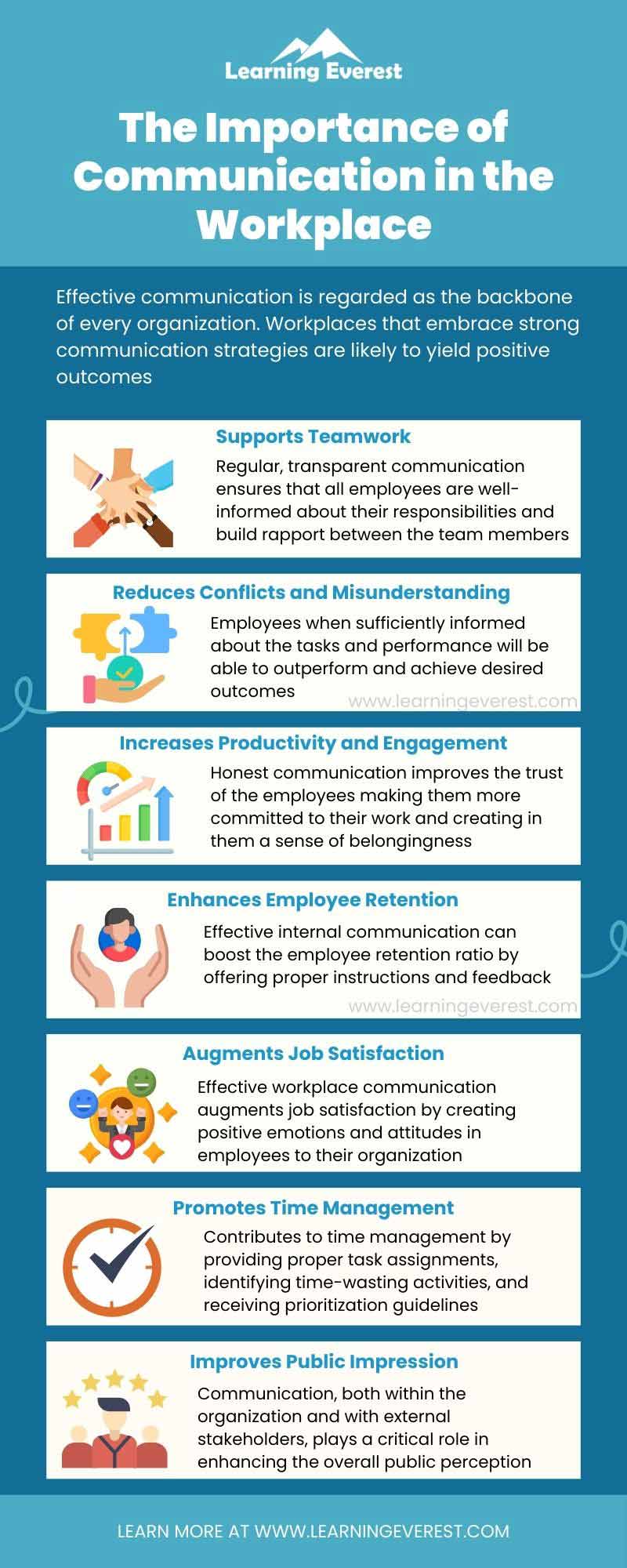Imagine a situation where an employee is not properly informed about the tasks to be performed or an employer is not updated about the status of performance. It would definitely affect the overall functioning of the organization. This proves the importance of communication in the workplace.
Table of Contents
- Types of Workplace Communication
- The Importance of Communication in the Workplace
- Importance of Communication in the Workplace #1 Supports Teamwork
- Importance of Communication in the Workplace #2 Reduces Conflicts and Misunderstanding
- Importance of Communication in the Workplace #3 Increases Productivity and Engagement
- Importance of Communication in the Workplace #4 Enhances Employee Retention
- Importance of Communication in the Workplace #5 Augments Job satisfaction
- Importance of Communication in the Workplace #6 Nurtures Time Management
- Importance of Communication in the Workplace #7 Improves Public Impression
- Conclusion
- Infographic
- Knowledge Check!
- Frequently Asked Questions (FAQs)
- What is the importance of communication in the workplace?
- What is the importance of communication in teamwork?
- What are the main types of communication used in the workplace?
- Why is open communication important in the workplace?
The following paragraphs discuss the different types of workplace communication and the importance of communication in the workplace. Keep reading!
Types of Workplace Communication
According to the Merriam-Webster Encyclopedia, communication refers to the “process by which information is exchanged between individuals through a common system of symbols, signs or behavior. Four different types of workplace communication can take place together or individually in organizational interactions. They are:

Types of Workplace Communication
Verbal Communication
The most common type of communication in every sphere of life is verbal communication. In the workplace, the role of verbal communication is very crucial. It involves the exchange of ideas and information through spoken words and can happen between colleagues, employees, and management. It can be face-to-face communication, virtual meetings and video conferencing, presentations, and informal grapevine communication.
Nonverbal Communication
Nonverbal communication is a powerful form of communication involving the exchange of ideas and information through gestures, facial expressions, eye contact, tone of voice, and pauses and can either occur on its own or accompany verbal communication. Nonverbal communication is as crucial as verbal communication “85% of people believe eye contact plays a vital role in business communication.” (Source: Pumble). This type of communication is essential to establish strong relationships in the workplace.
Written Communication
Formal communication is best conveyed using written channels and the exchange of ideas and information through such channels is referred to as written communication. It can include emails, memos, reports, letters, newsletters, proposals, policies, etc., and is largely preferred in organizations on formal matters due to the opportunity for permanent record-keeping.
Visual Communication
Communication that uses visual elements such as charts, graphs, logos, infographics, videos, diagrams, posters, etc. to convey information and ideas is called visual communication. This type of communication is vital in communicating complex ideas in the workplace.
Formal communication in an organization can be horizontal, vertical, or diagonal with communication taking place at the same level being considered as horizontal communication, the flow of ideas and information based on a hierarchical pattern as vertical communication, and the exchange of ideas between different levels at different teams or departments as diagonal communication. Vertical communication can flow upward from employees to the management or downwards from senior management to the employees. All these types of communication play a crucial role in the workplace.
The Importance of Communication in the Workplace
Effective communication is regarded as the backbone of every organization. The communication involving the exchange of information in the two-way path including sharing messages and providing feedback completes the process. According to Project.co Communication Statistics 2024, “53% of people have suffered from burnout, stress, and fatigue due to communication issues in their business.” Workplaces that embrace strong communication strategies are likely to yield positive outcomes.
Importance of Communication in the Workplace #1 Supports Teamwork
Regular, transparent communication ensures that all employees are well-informed about their roles and responsibilities and contributes to building rapport between the team members. When teammates communicate their expectations and the specific tasks, it fosters an opportunity to collaborate and effectively contribute to the whole project. In addition to communicating about their work, communication involving casual conversations, water cooler talk, group chats, etc. contributes to building strong team connections.
Importance of Communication in the Workplace #2 Reduces Conflicts and Misunderstanding
Open and consistent communication is essential for reducing conflicts and misunderstandings. Employees, when sufficiently informed about the tasks and performance will be able to outperform and achieve desired outcomes. On the other hand, disrupted and biased communication within an organization affects trust and creates conflicts and confusion among the members. According to Forbes, “Poor communication is affecting the work of 45% of the workers.”
Importance of Communication in the Workplace #3 Increases Productivity and Engagement
Workplace communication contributes to employee engagement and thereby enhances productivity. Honest communication improves the trust of the employees making them more committed to their work and creating in them a sense of belongingness. Well-informed employees can reap higher outcomes as they can engage completely in the work. Moreover, the employees could feel that they are being listened to in their organization, improving loyalty and productivity.
Importance of Communication in the Workplace #4 Enhances Employee Retention
Retaining top-notch talent is a crucial factor in the success of an organization. Effective internal communication can boost the employee retention ratio by offering proper instructions and feedback. It further ensures that every member rightly understands their roles and responsibilities letting them focus on their tasks. These factors improve the retention rate of the employees. ZenHR Whitepaper Employee Retention Strategies for 2022 states, “Effective team communication increases employee retention by 4.5 times, compared to businesses that lack effective communication in the workplace.”
Importance of Communication in the Workplace #5 Augments Job satisfaction
Effective workplace communication augments job satisfaction by creating positive emotions and attitudes in employees to their organization. Through proper interaction involving both formal and informal communication, employees feel satisfied with the roles and responsibilities they undertake and the work environment.
Importance of Communication in the Workplace #6 Nurtures Time Management
Studies suggest that “76% of people believe improving their time management will boost their reputation at work.” (Source: Timewatch). Workplace communication is a decisive factor contributing to nurturing time management by providing proper task assignments, identifying and resolving time-wasting activities, and receiving prioritization guidelines. Furthermore, through communication employees grab an idea of the fruitful adoption of tools and techniques for maximized output which contributes to managing time effectively.
Importance of Communication in the Workplace #7 Improves Public Impression
Communication, both within the organization and with external stakeholders, plays a critical role in enhancing the overall public perception. When internal communication contributes to increased productivity and outcomes resulting in customer satisfaction, external communication with clients and customers raises the value of the brand and improves public impression.
A blog post by Grammarly titled The State of Business Communication: New Threats and Opportunities published in 2023 found that “Leaders report increased productivity (72%), increased customer satisfaction (63%), and increased employee confidence (60%) as the top three benefits of effective communication.”
Conclusion
In conclusion, communication serves as the backbone of any successful workplace, influencing organizational performance and job satisfaction. Workplace communication including the types of verbal, non-verbal, written, and visual communication plays an indispensable role in establishing open interaction in the workplace. Formal as well as informal communication is highly significant in every organization to ensure all the employees stay connected and well informed about their roles and responsibilities.
The importance of communication in the workplace is that it supports teamwork, reduces conflicts and misunderstandings, increases productivity and engagement, enhances employee retention, augments job satisfaction, nurtures time management, and improves public impression. By adopting strong communication strategies, organizations can promote a culture of harmony and yield maximum outcomes. It is recommended that all organizations realize the importance of communication in the workplace and promote strategies to encourage internal and external communication for operational efficiency and a positive work culture.
Infographic

The Importance of Communication in the Workplace
Knowledge Check!
Frequently Asked Questions (FAQs)
What is the importance of communication in the workplace?
The importance of communication in the workplace is that it supports teamwork, reduces conflicts and misunderstandings, increases productivity and engagement, enhances employee retention, augments job satisfaction, nurtures time management, and improves public impression.
What is the importance of communication in teamwork?
Regular, transparent communication ensures that all employees are well-informed about their roles and responsibilities and contributes to building rapport between the team members.
What are the main types of communication used in the workplace?
Four different types of workplace communication can take place together or individually in organizational interactions. They are verbal communication, nonverbal, written and visual communication.
Why is open communication important in the workplace?
Open and consistent communication is essential for reducing conflicts and misunderstandings. Honest communication improves the trust of the employees making them more committed to their work and creating in them a sense of belongingness.






